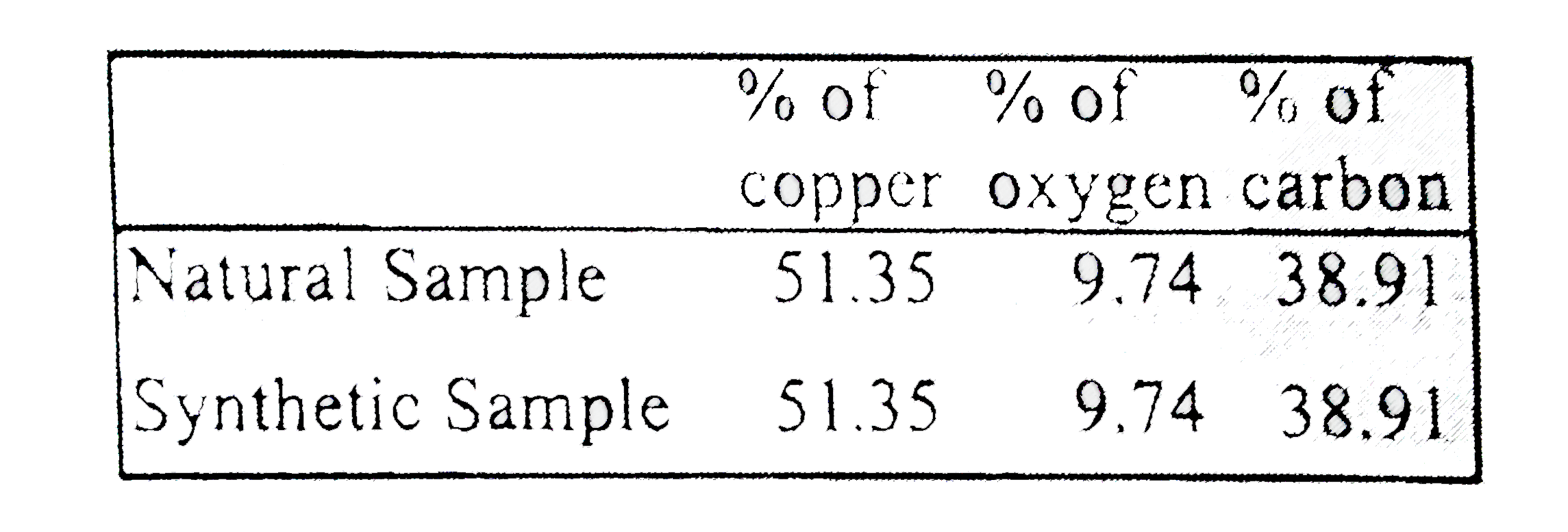This law was given by, a French chemist , Joseph Proust. He stated that a given compound always contains exactly the same proportion of elements by weight.
Proust worked with two samples of curpic carbonate- one of which was of natural origin and the other was synthetic one . He found that the composition of elements present in it was for both the samples as shown below:
Thus, irrespective of the source, a given compound always contains same elements in the same proportion. The validity of this law has been confrmed by various experiments. It is sometimes also reffered to as Law of constant composition.
Limitation:
This law is not applicable if the compound is formed from different isotopes of an element . The two isotopes of carbon C-12 and C-14 form carbondioxide C12O2 and C14O2 . The ratio of C : O is 12 : 32 and 14 : 32 respectively .It is not a constant ratio.
0.5 G silver is dissolved in excess of nitric acid. This solution is treated with excess of NaCl solution when 0.66 g AgCl is formed. One gram metallic silver wire is heated in dry Cl2 ,1.32 g AgCl is formed . Show that these data confirm the law of constant proportion.

The correct Answer is:%Ag=0.50.66×100=75.75
%Ag=11.32×100=75.75
In both AgCl,% Ag is same,
Topper's Solved these Questions
- MOLE CONCEPTBOOK - ALLENCHAPTER - MOLE CONCEPTEXERCISE - O-I
45 Videos
- MOLE CONCEPTBOOK - ALLENCHAPTER - MOLE CONCEPTEXERCISE - O-II
14 Videos
- MOLE CONCEPTBOOK - ALLENCHAPTER - MOLE CONCEPTEXERCISE - S-I (Problems Related with Different Types of Atomic Masses & Basic Concept of Mole)
53 Videos
- METALLURGYBOOK - ALLENCHAPTER - METALLURGYEXERCISE - EXERCISE-05 [B]
26 Videos
- p-Block Element BOOK - ALLENCHAPTER - p-Block Element EXERCISE - All Questions
20 Videos
Similar Questions
This law was given by, a French chemist , Joseph Proust. He stated that a given compound always contains exactly the same proportion of elements by weight.
Proust worked with two samples of curpic carbonate- one of which was of natural origin and the other was synthetic one . He found that the composition of elements present in it was for both the samples as shown below:
Thus, irrespective of the source, a given compound always contains same elements in the same proportion. The validity of this law has been confrmed by various experiments. It is sometimes also reffered to as Law of constant composition.
Limitation:
This law is not applicable if the compound is formed from different isotopes of an element . The two isotopes of carbon C-12 and C-14 form carbondioxide C12O2 and C14O2 . The ratio of C : O is 12 : 32 and 14 : 32 respectively .It is not a constant ratio.
6.488 g lead with 1.002 g oxygen to form an oxide. This oxide is also obtained by heating Pb(NO3)2, It is found that % of lead in this oxide is 86.62 .Show that these date illustrate the law of definite proportions.

View SolutionThis law was given by, a French chemist , Joseph Proust. He stated that a given compound always contains exactly the same proportion of elements by weight.
Proust worked with two samples of curpic carbonate- one of which was of natural origin and the other was synthetic one . He found that the composition of elements present in it was for both the samples as shown below:
Thus, irrespective of the source, a given compound always contains same elements in the same proportion. The validity of this law has been confrmed by various experiments. It is sometimes also reffered to as Law of constant composition.
Limitation:
This law is not applicable if the compound is formed from different isotopes of an element . The two isotopes of carbon C-12 and C-14 form carbondioxide C12O2 and C14O2 . The ratio of C : O is 12 : 32 and 14 : 32 respectively .It is not a constant ratio.
6.488 g lead with 1.002 g oxygen to form an oxide. This oxide is also obtained by heating Pb(NO3)2, It is found that % of lead in this oxide is 86.62 .Show that these date illustrate the law of definite proportions.

View Solution
Knowledge Check
"A given compound always contains exactly the same proportion of elements by weight." is the statement of
ALaw of Conservation of MassBLaw of Definite ProportionCLaw of Multiple ProportionDAvogadro LawProust worked with the two samples of cupric 3 carbonate one of which was of natural origin and the other' was synthetic one. He found that the composition of elements present in it was same for both the samples as shown below.

Which law is in favour of the above data?ALaw of multiple proportionsBGay Lussac's law of gaseous volumesCAvogadro's lawDLaw of definite proportionsWhich one of the following is not a synthetic element ?
ATechnetiumBNeptuniumCAstatineDUranium
Assertion: 12 parts by mass of carbon in CO and CO2 molecules combine with 16 and 32 parts by mass of oxygen.
Reason : A given compound always contains exactly the same proportion of elemetns by weight.
View SolutionIn a chemical compound , the constituent elements are present in …………. Proportions by weight .
View SolutionAn element forms two oxides containing, 50% & 40% of oxygen respectively by weight of the element. Does these oxides illustrate the law of multiple proportions :-
View SolutionWhich one of the elements is not found in nature?
View SolutionThe compounds which contain one or more atoms of other elements in a ring of carbon atoms are called
View Solution
